
MAXTRAX MKII Recovery Boards & Tire Mount Review For the 5th Gen 4Runner: The Only Recovery Boards You’ll Ever Need
If you happen to be like me and go out on adventures by yourself, odds are you’ve been in a few positions where you needed a way to self-recover, whether it be in slick snow, loose sand or thick mud.
While not everyone has the ability to mount a winch on their 5th Gen 4Runner, there are other options to help with recovery, such as the MAXTRAX Recovery Boards.
Who is MAXTRAX?
MAXTRAX is a company based out of Australia and is known for its recovery boards.
Their idea popped up during an adventure in 2001 where their vehicle nearly got taken out to sea by the rising tide, due to being stuck in the sand. Since then, they have become the #1 traction board option throughout 30+ countries.
What is MAXTRAX?
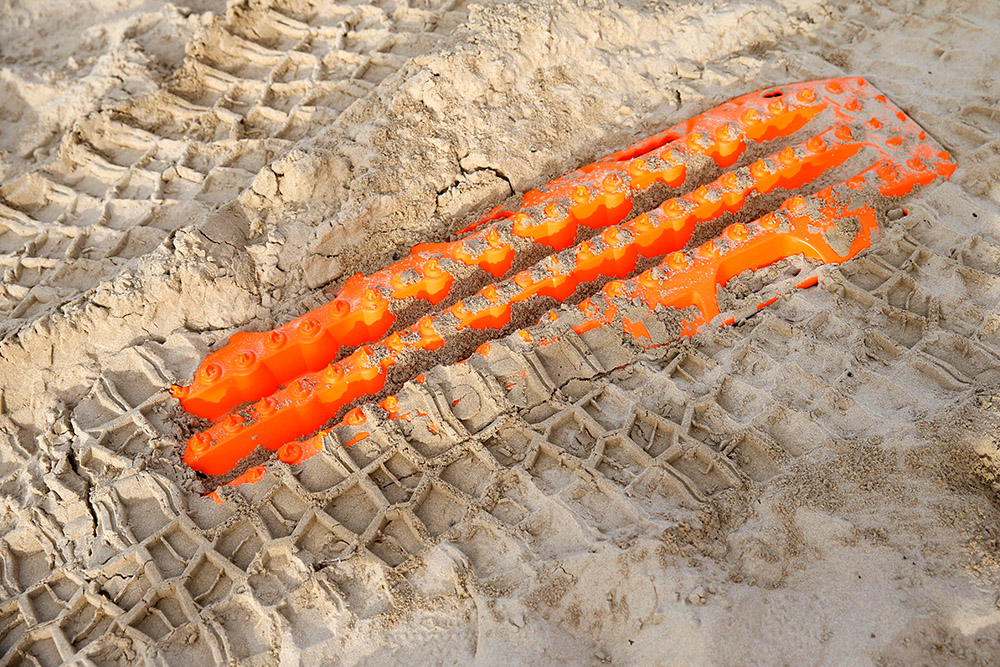
If you happen to not know what MAXTRAX is, it’s a self-recovery board that can help you get out of most situations where you find yourself stuck. In fact, they sometimes have been proven to be more useful than a winch in a few scenarios.
The boards have grooves and ‘cleats’ in them which allow them to dig into the tire to allow traction to help you get unstuck. They are alsohttps://amzn.to/38I9TNz able to be stacked on top of each other and are able to handle UV rays.
Each board weighs 7.5lbs and is 45” L x 13” H, which makes it extremely easy to carry around, even in some of the most difficult terrain. You can even use them as a makeshift shovel if you don’t happen to have one.
Find it online:
- MAXTRAX recovery boards: Check Price
- MAXTRAX MKII Rear Wheel Harness: Check Price
Why MAXTRAX?
With so many options on the market, you might have a tough time deciding which recovery board option to go with. I know I did. However after reading around, watching countless videos, it was quite simple on who to go with, the original recovery board makers, MAXTRAX.
Compared to other boards, MAXTRAX recovery boards were not seen breaking when you needed to count on them the most.
After all, what good is a recovery board if it’s broken and you are unable to use it? MAXTRAX has also won global awards for their stellar product at SEMA which speaks volumes in itself.
Spare Tire Mounting
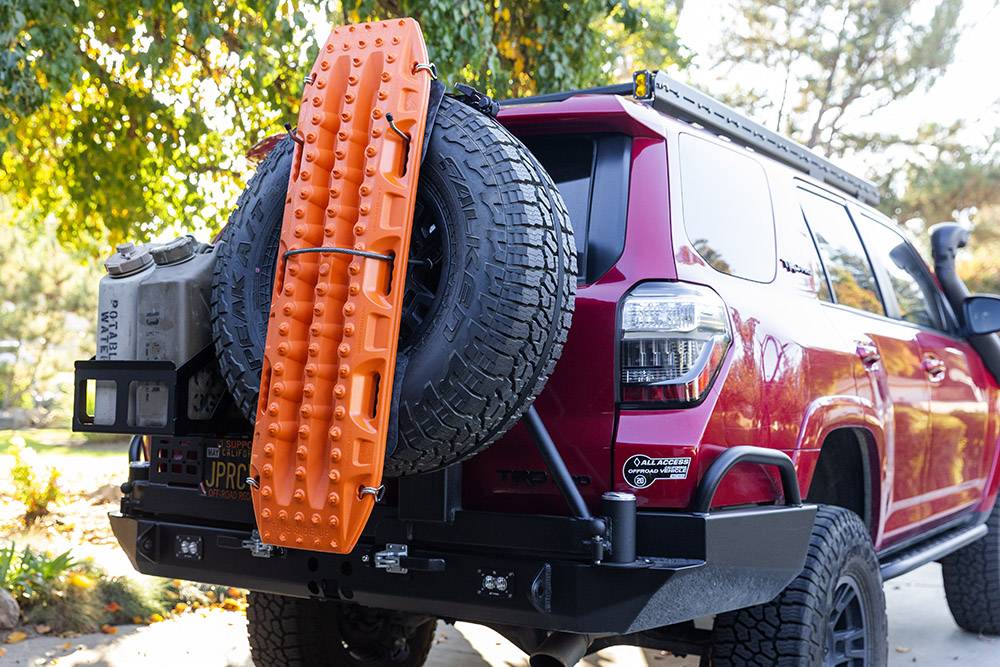
When it comes to mounting MAXTRAX, there are numerous ways it can be done.
Some of the more popular options are the roof and the spare tire. Because of the height of my 4Runner and the garage, I decided it was best to go with the tire mount as I would have no issues getting into my garage.
Another reason I like the spare tire mount is it allows you to get to the MAXTRAX recovery boards in a much faster and easier way than if it were on the roof. This could be extremely beneficial if, for some reason, you find yourself tilting and don’t want to add more weight to where the vehicle may topple over.
The MAXTRAX are also able to be adjusted depending on the ground clearance you are looking for. Keep in mind when you are climbing steep terrain, if the MAXTRAX hangs too low it could snag and possibly break, which is why it’s important to keep it higher than lower. A good rule of thumb is if it hangs higher than your hitch you should be more than okay, as the hitch is typically what hits first.
Ratchet Strap

One thing I love about the tire mounting kit is that it uses ratchet straps. While some companies use buckles and velcro, with a ratchet strap you know your item is going to stay where it is unless a user error occurred.
Growing up on a farm ratchet straps were used nearly all the time, so when I knew the MAXTRAX tire kit used this style of security, I was confident my MAXTRAX wouldn’t fall off somewhere on the highway or backroad route.
The main thing that is needed to be kept in mind is that you want the strap to be dead center of the tire. This ensures there is no way a strap falls off on the edge. Not to mention you are able to get a better connection on the tire by it being dead center than if it were on the lip.
This can be a bit of a struggle if you happen to run larger tires, but it’s not something you need two people for. I found if you slightly tighten down the ratchet strap you are able to maneuver it a bit, without having it be completely flimsy such as you would if it weren’t semi-tight.
MAXTRAX also made sure to include a velcro strip at the end of the straps so there is no way you have a flapping strap in the wind. This is also convenient for wind noise. If you’ve ever strapped anything down with a ratchet strap you probably know the annoying amounts of noise they can make flapping in the wind.
If you have large tires MAXTRAX has you covered as their ratchet straps are capable of fitting a 37” tire size. The odds are you aren’t running something that big so you can feel comfortable knowing this will work on your vehicle.
Centering the Holder

Before completely tightening down the ratchet strap around the tire you need to make sure the holder itself is dead center of the tire. This allows your MAXTRAX to sit vertically rather than leaning or on its side. This is extremely vital as the two upper hooks which help keep the boards sitting in place are there, and if they aren’t in the correct position the boards could fall off.
Another reason you want the holder to sit center is that MAXTRAX threw in a handy accessory pouch where you can hold things you want to get too fast. Perhaps your air down tool or D rings. Of course, you can also use this for the straps they include with the recovery board for situations to help you find them easier when they get buried.
This is helpful in situations where recovery needs to be done quickly. Perhaps on the beach wide the tide coming in. The last thing you want to do is waste precious seconds digging through your recovery box for the air down tool when you could have it at hands reach behind the boards.
MAXTRAX also threw in a nice add-on with the rubber pads that protect your tire (and the recovery boards) from rubbing against each other. This helps keep the boards in a healthy state, while also not adding rub marks on your tire. Though I suppose if you use your spare with tire rotations, you may already have marks on your tire.
Tighten Hooks
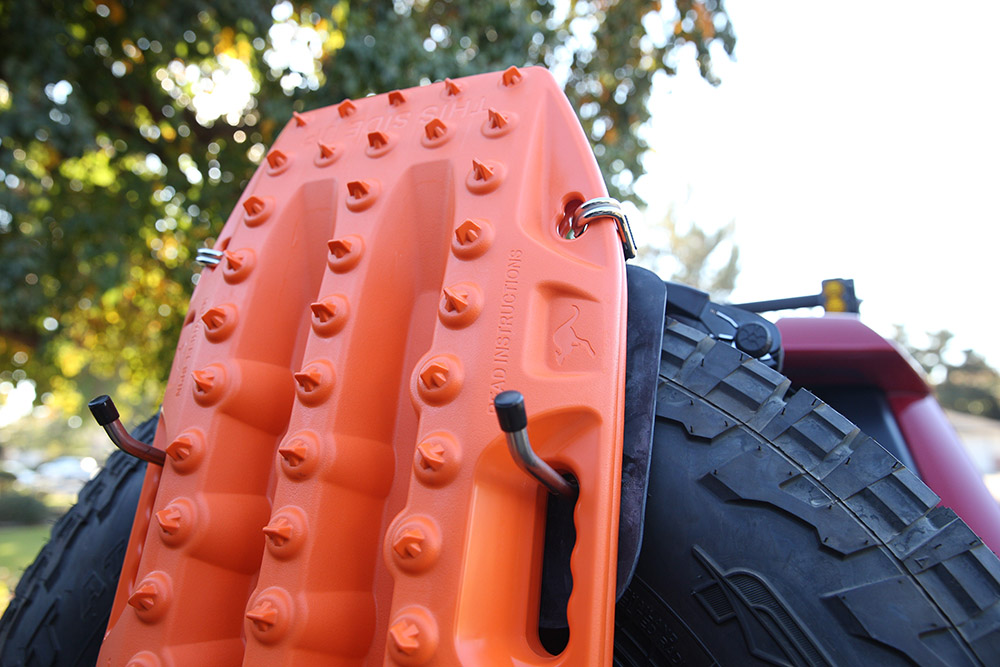
There are four sets of hooks that come with the secondary ratchet straps. These are to be installed after you have set up the holder. While you can do this part with your tire swing out closed, it’s most certainly easier to do it with the swing-out open.
You simply want to connect the four hooks into the smaller section holes of the two upper and two lower sections of the MAXTRAX recovery boards. Once they are in the position you simply ratchet down on the straps until they are snug enough to hold the boards in place. You typically know this by how hard it is to ratchet with the straps. There’s no need to do it so much where it’s impossible to ratchet, but rather stop once you can feel a decent amount of resistance.
Testing the MAXTRAX
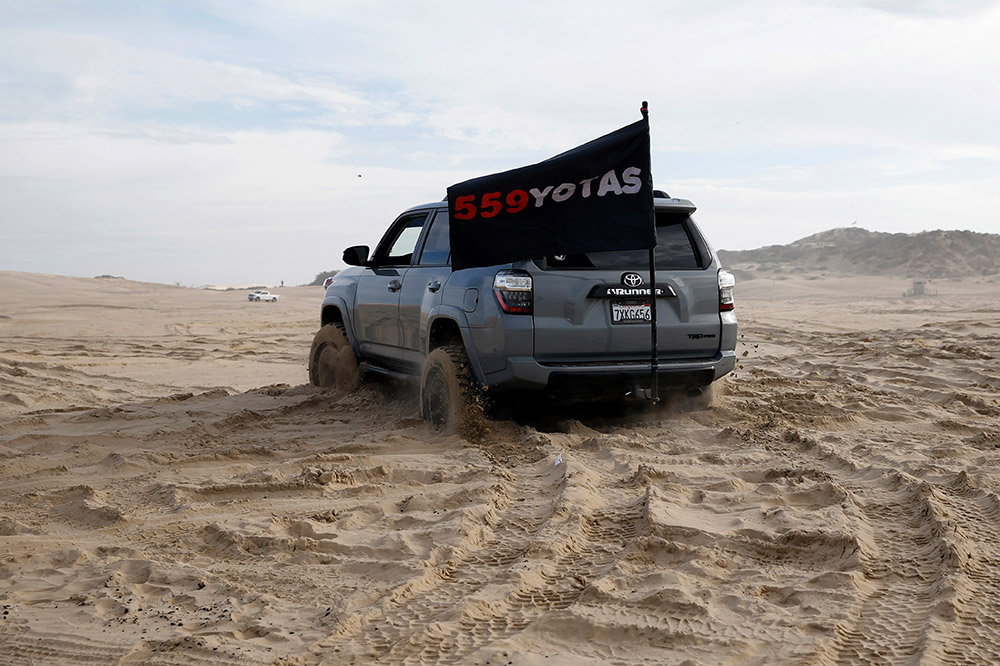
Like with any new product you want to be able to test them out. Whether it be lights, communication, tires, you always want to get out there and see the difference they make. Unfortunately with the Creek Fire I was unable to get out for a while to test these, but thanks to the Oceano Dunes SVRA opening back up recently, I was able to put these to good use thanks to a friend.
One of our favorite things to do is bury the 4Runners in the sand, and then put the crawl control on and let people watch them literally rise out of the sand. So, that’s exactly what we did this time. Except for this time, the 4Runner didn’t crawl out. It seems as if you either need to be in a flat area, or somewhere with a big enough angle where you can put it in reverse, and gravity helps.
This time the angle wasn’t flat enough, but also not steep enough, and the 4Runner for once met its nemesis. Even after airing down the 4Runner had dug deep enough in that there was no coming out of it with just the crawl system alone. Thankfully I always carry the MAXTRAX with me no so we popped them out and put them to the test.
Positioning the MAXTRAX
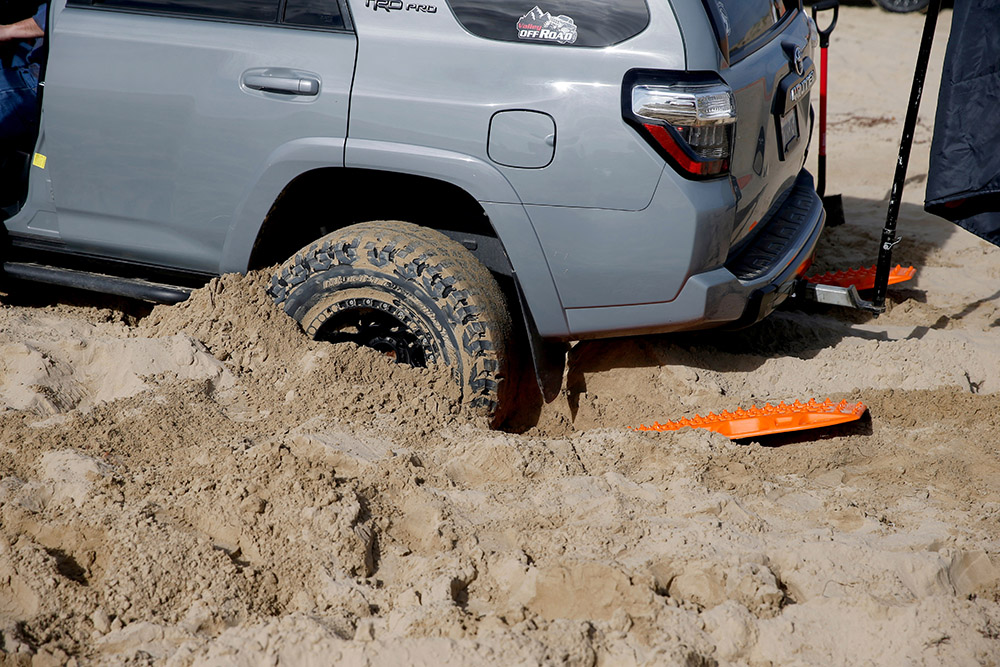
It’s important to position the MAXTRAX in the correction location. This allows for the tires to grab instantly vs never grabbing at all. Being this was my first time using them there was definitely a minor learning curve, but at the end of the day, dig enough to where about 1/4th of the tire is able to touch the board, you should be good to go from there.
We also had to position the boards around to different tires. This was a clear sign that you can get things done with two boards, but you’ll likely want to have four to help speed up the process. Obviously, we didn’t have to deal with a tide but had we it might have made the situation quite stressful.
In the end, the two rear wheels seemed to have the best chances at grabbing so that’s where we kept them — and it, sure enough, did get us out.
Final Thoughts
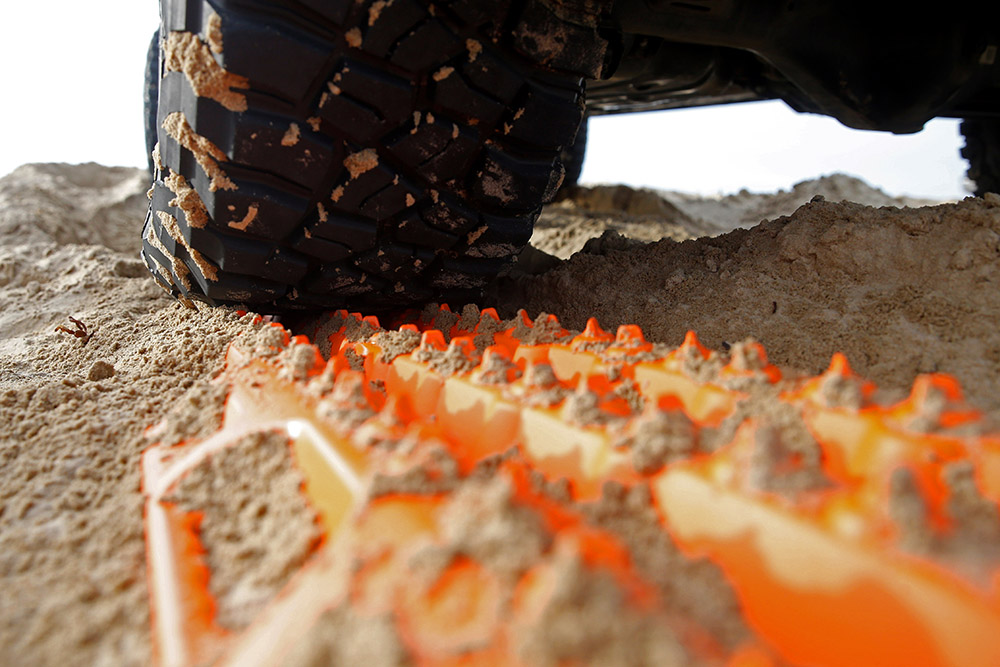
If you are looking for recovery options, MAXTRAX recovery boards are a top option, especially for the price. With the ability to stack up to four of these at a time (five if they are all clean), you can feel confident going into soft sand or slippery snow and know if you get stuck you’ll make it home in no time.
If you have a swing-out style spare tire carrier this setup is a great option, however for those of you who do not, this might be a difficult option when swinging down depending on your setup. Ideally, you should be able to get away with it as long as the recovery board doesn’t sit far below the tire where it may run into any of the supports or bumper of your vehicle.
I can now say in areas where my winch may not be practical to use, such as in sandy areas at the beach, I feel confident that if I were to get stuck, or anyone else that I may come across, that I would easily be able to self recover or get them out.

They have a good product but HORRIBLE customer service-not worth the hassle and you pay too $$$